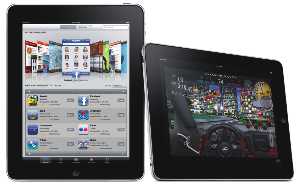Earlier this week I read a report about creating a geographic data system for a community group in Lawrence, Massachusetts. The document contained detailed technical documentation for how to use iPAQ handheld computers to collect geocoded data. Since the data was collected and managed in geographic information system (GIS) software, it required pages of technical instructions. This case seemed a prime example of how GIS tools missed the mark for planners who need to work with geographic data, but in a different way than technical analysts. The purpose of the project was to empower community youth to collect basic data, a task ill suited to software designed for data management by experts using hundreds of attributes and a fine degree of precision.One day later, I found myself reading Newsweek's cover story about the iPad, which reported that Apple expects to sell hundreds of thousands of the sturdy, easy-to-use devices in the coming months. Could the iPad be used for planning? I have previously written about the potential for the iPhone to augment city life. Since then the types of apps I described have only grown in popularity: navigation apps that use transit data, apps to report potholes or other issues to city officials, augmented reality apps providing information about your surroundings, and geographic networking and gaming like FourSquare.
 Earlier this week I read a report about creating a geographic data system for a community group in Lawrence, Massachusetts. The document contained detailed technical documentation for how to use iPAQ handheld computers to collect geocoded data. Since the data was collected and managed in geographic information system (GIS) software, it required pages of technical instructions. This case seemed a prime example of how GIS tools missed the mark for planners who need to work with geographic data, but in a different way than technical analysts. The purpose of the project was to empower community youth to collect basic data, a task ill suited to software designed for data management by experts using hundreds of attributes and a fine degree of precision.
Earlier this week I read a report about creating a geographic data system for a community group in Lawrence, Massachusetts. The document contained detailed technical documentation for how to use iPAQ handheld computers to collect geocoded data. Since the data was collected and managed in geographic information system (GIS) software, it required pages of technical instructions. This case seemed a prime example of how GIS tools missed the mark for planners who need to work with geographic data, but in a different way than technical analysts. The purpose of the project was to empower community youth to collect basic data, a task ill suited to software designed for data management by experts using hundreds of attributes and a fine degree of precision.
One day later, I found myself reading Newsweek's cover story about the iPad, which reported that Apple expects to sell hundreds of thousands of the sturdy, easy-to-use devices in the coming months. Could the iPad be used for planning? I have previously written about the potential for the iPhone to augment city life. Since then the types of apps I described have only grown in popularity: navigation apps that use transit data, apps to report potholes or other issues to city officials, augmented reality apps providing information about your surroundings, and geographic networking and gaming like FourSquare.
The iPad shares the capabilities that make the iPhone so useful in urban contexts: it is highly mobile, location aware, and some iPads are 3G-connected. For planning, an important difference is the larger screen. Not only does it make it easier to record data in the field, it could be used to pull up renderings, images, and other data on the go. In a small meeting, the iPad could sit on the table allowing for the functionality of a touch table without the hassle and expense of the real thing. In short, it creates the potential for collaborative mobile computing with an easy-to-use yet technically sophisticated device.
Of course, much of the potential will be limited by the available software. The functions I am describing may not be sufficiently lucrative to attract developers, or seem too specialized for Apple to include in their store. Assuming that like the iPhone, the browser can query the device's location, one solution could be websites designed for planning purposes. Someday we could even see an city data portal, pulling up local property ownership, zoning, land use, permitting, and crime data as you walk down the street.
Then again, planners are often the first to point out that problems are rarely solved by technology, no matter how "magical" it is (to use Apple's term for the iPad). New devices only expend our toolkit for the hard work of good planning.

Analysis: Cybertruck Fatality Rate Far Exceeds That of Ford Pinto
The Tesla Cybertruck was recalled seven times last year.

National Parks Layoffs Will Cause Communities to Lose Billions
Thousands of essential park workers were laid off this week, just before the busy spring break season.

Retro-silient?: America’s First “Eco-burb,” The Woodlands Turns 50
A master-planned community north of Houston offers lessons on green infrastructure and resilient design, but falls short of its founder’s lofty affordability and walkability goals.

Test News Post 1
This is a summary

Analysis: Cybertruck Fatality Rate Far Exceeds That of Ford Pinto
The Tesla Cybertruck was recalled seven times last year.

Test News Headline 46
Test for the image on the front page.
Urban Design for Planners 1: Software Tools
This six-course series explores essential urban design concepts using open source software and equips planners with the tools they need to participate fully in the urban design process.
Planning for Universal Design
Learn the tools for implementing Universal Design in planning regulations.
EMC Planning Group, Inc.
Planetizen
Planetizen
Mpact (formerly Rail~Volution)
Great Falls Development Authority, Inc.
HUDs Office of Policy Development and Research
NYU Wagner Graduate School of Public Service


























